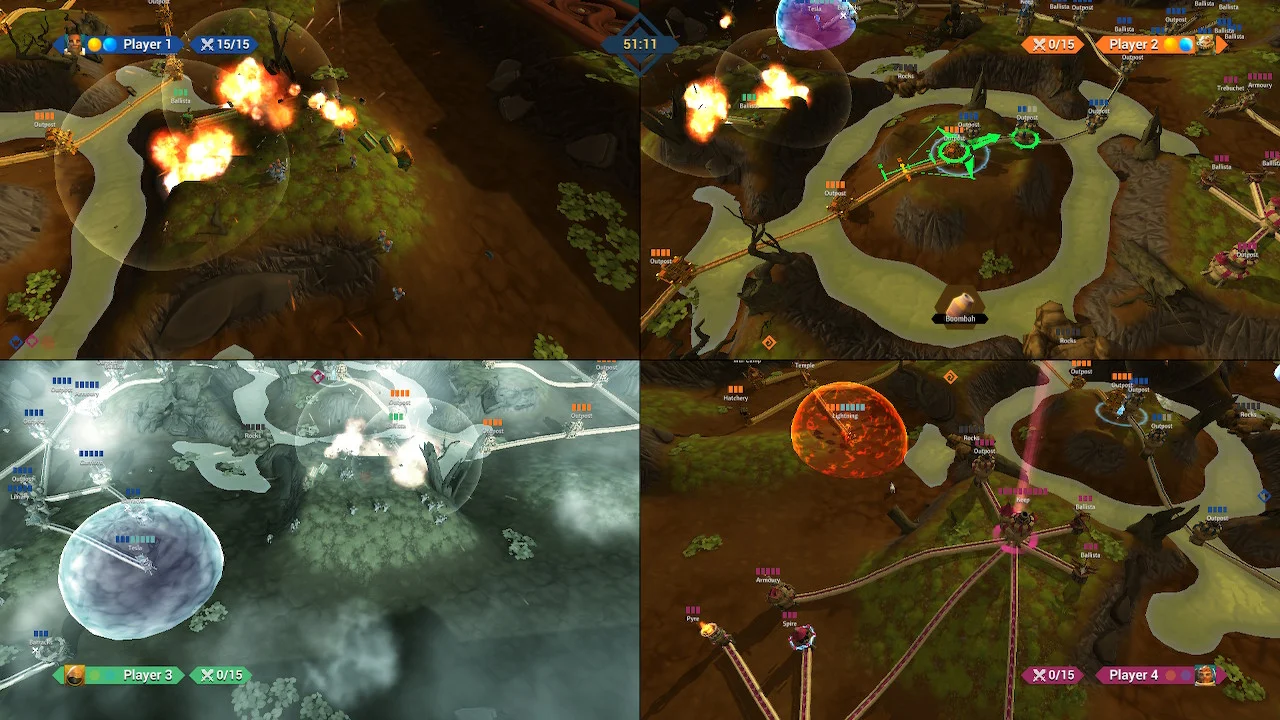Pete Witcher is a Feature and Community Writer for Blowfish Studios.
I’ve been playing a lot of Siegecraft: Commander (SC:C) lately and I’m reminded why I keep coming back to this unique RTS game. At first glance, SC:C seems like a traditional real-time strategy game where opponents expand their bases and deploy ground and air units to destroy their enemy’s base. But this game has loads of little quirks and surprises that make the gameplay feel both familiar and refreshing. Just one example: VR mode on the Steam version. The first time I played SC:C in virtual reality and saw the game appear in 3D at a tabletop scale, it took my breath away. I couldn’t stop smiling!
I love how I can jump into single player mode as the Knights or the Lizardmen for a quick (or long) game whenever I have some free time. Both sides have their own stories, and each victory unlocks a new level and a new chapter in the storyline, which makes the single-player battles more interesting.
The Knights of Freemoi fighting against the Lizardmen.
Siegecraft: Commander’s multiplayer mode gives me the option to engage my opponent with turn-based or real-time rounds, and I can customize several other options as well. You really get the sense that the designers really looked at the game from the player’s perspective and accommodated both fast and slow play styles.
The friendly multiplayer menu makes finding an online match fast and easy. Multiplayer features local or online play, and the Switch version features cross-platform multiplayer with Steam and Xbox One, so I can challenge my friends who have different platforms than mine.
Siegecraft Commander Gameplay
So, gameplay. It’s that good-old RTS stuff we love, plus surprises. You take command of the human Knights or their enemies the reptilian Lizardmen, plan your strategy, and execute on the battlefield. You have units and towers at your disposal that march, fly, make magic, launch short- or long-range projectiles, generate shields, and spawn dragons. In typical RTS fashion, you use them to expand to within striking range of the enemy Keep. Destroy the keep, win the round.
The biggest surprise in the game for me was the unique way you build towers: by launching them with a catapult. Where the catapult’s missile lands, a tower rises.
At the beginning of each round, you select your Keep and a new tower to build, click and drag a 3D launching mechanism that appears right on the map. It looks like a crossbow on the ground, and as you “draw back” the crossbow, an arcing shot guide appears on the map to show you the catapult missile’s trajectory and landing point. If the catapult missile lands on a suitable surface, a new tower pops up in that spot with a wall reaching back to the tower that launched it. Each tower has its own menu of sub-towers it can launch and build.
It makes the building process surprisingly fun, like launching paper projectiles with a rubber band, or rocks from a slingshot. And the more you use this tower-launching gizmo, the faster you get. And speed can make the difference between victory and defeat in some games … but not all. There’s that theme again of including different playing styles.
Siegecraft Commander offers a variety of battle environments across two campaigns.
I really enjoyed discovering the physics of this tower-wall element of the game. There are rules that determine where you can build, and the very physics of the building mechanics have their own subtle constraints and balancing. For example, the walls that connect towers cannot overlap; attempting to do so will result in a failed construction attempt, and the cooldown period still applies. That means one tower can only build a finite number of sub-towers.
The connected nature of the towers creates challenges as well as opportunities. You can build towers in segments, like a fortress wall, or build them in starburst patterns, with several towers radiating out from a single hub structure. Sometimes I quickly build walls around my opponent’s troops to cut them off from support or funnel my infantry to the enemy’s weak spot. The design and strategy styles seem virtually limitless.
But it’s important to consider how you use space when expanding your base. It’s all too easy to accidentally pen up your infantry with other towers’ walls or build up densely-packed defenses against ground troops and leave no room for air defense when the enemy switches tactics.
These new challenges and discoveries make SC:C so interesting and so much fun. The single-player campaigns are a great place to start. You can brush up on your skills and try out different strategies as you prepare to take on human challengers.
The Knight Campaign, “Voyage for Glory”
In the Knight campaign, you protect your base and launch offensives with specialized towers and units like outposts, garrisons, ground troops, and dirigibles. If the enemy’s defenses are focused on air attacks, you could build a cluster of barracks and deploy never-ending waves of AI-driven ground units for a land-based attack. Or if the enemy base is lined with troop-crushing barrages, plan your air attack: capture a gold deposit and launch a string of dirigibles a carve a path of destruction into your opponent’s base.
Aim and fire your catapult to build towers and other structures!
Or maybe you’d prefer rapidly catapulting outposts to within firing range of the enemy’s fortress, where you can set up several outpost towers for some short-range firepower, or long-range trebuchets that deal damage from outside the enemy’s reach but are balanced by a longer cooldown. Once your towers are in position, you can shell the enemy’s base with exploding powder kegs and exploding … cows. The bovine projectiles deal more damage, and also require a longer cooldown than your garden variety exploding powder keg.
The story finds the human Knight army freshly crash landed in Lizardman territory. The environment changes as the story progresses, from green lowlands to snowy foothills. I enjoyed learning what defenses and weaponry the Lizardmen had on hand, or on claw. I tried a few things to counter their attacks and ended up hammering away at their lightning shield to expose their Wyvern hatchery to a ground attack. I captured a gold deposit and thus unlocked my airborne dirigible units. I used the dirigibles’ height advantage to destroy the Lizardmen’s hard-to-reach totems and snuff out their range-reducing magic spells.
The Lizardman Campaign, “Crusade of Hope”
At the start of the Lizardman campaign, we must defend against a surprise attack from our previously-peaceful neighboring tribe, the Hurtrads. Why did they attack us? We battled mightily in search of the answer and uncovered some shocking twists and turns as the chapters unfolded.
The Lizardmen fighting against their neighboring tribe, the Hurtrads.
When I played the Lizardman campaign, I noticed the tech tree is mostly the same as the Knights’ tech tree, with some key differences. Everything’s skinned properly of course, and you have war camps instead of garrisons, but their function is the same: to generate ground troops. Also you have wyverns, which are powerful air units that can be launched in rapid succession. The story led my Lizardmen from the rippled sands of our desert home into forbidding swamps and seething lava beds. The swamps are filled with boggy muck that slows down everything that slogs through it or rests on it. Ground troops move more slowly in it, towers have reduced range, and cooldown times are doubled. So obviously I built my towers on the dry-ground hummocks and hilltops rising out of the swamp here and there. I eschewed the ground game because of the muck and focused on overbuilding air defenses around my densely-build base. With enough auto-firing ballistas and barrages, I insulated my base from ground and air attacks. Then I concentrated on launching towers from hilltop to hilltop, protecting everything with ballistas to fend off pesky enemy dirigibles, and building a battery of trebuchets just out of the enemy’s firing range. Having multiple long-range offensive towers is key to overcoming the enemy’s ballistas, which will negate your first missile but won’t be able keep up with multiple trebuchets.
Siegecraft: Commander refreshes the RTS genre with a groundbreaking new tower construction feature, minimal micromanagement, no economy to slow down expansion, and a simple but robust tech tree. These new additions and fun, familiar RTS elements make Siegecraft: Commander a joy to discover and endlessly playable.
Siegecraft Commander brings 4-person split-screen multiplayer to the Nintendo Switch!
Purchase Siegecraft Commander for Nintendo Switch here.
Starting the week of September 24th, 2018, and continuing for the next several weeks, the official Blowfish Studios YouTube channel will be posting video walkthroughs for both Siegecraft Commander campaigns! Visit Chapter 1 of The Knight's Campaign, "Voyage for Glory," here, and Chapter 1 of The Lizardmen's Campaign, "Crusade of Hope," here.







